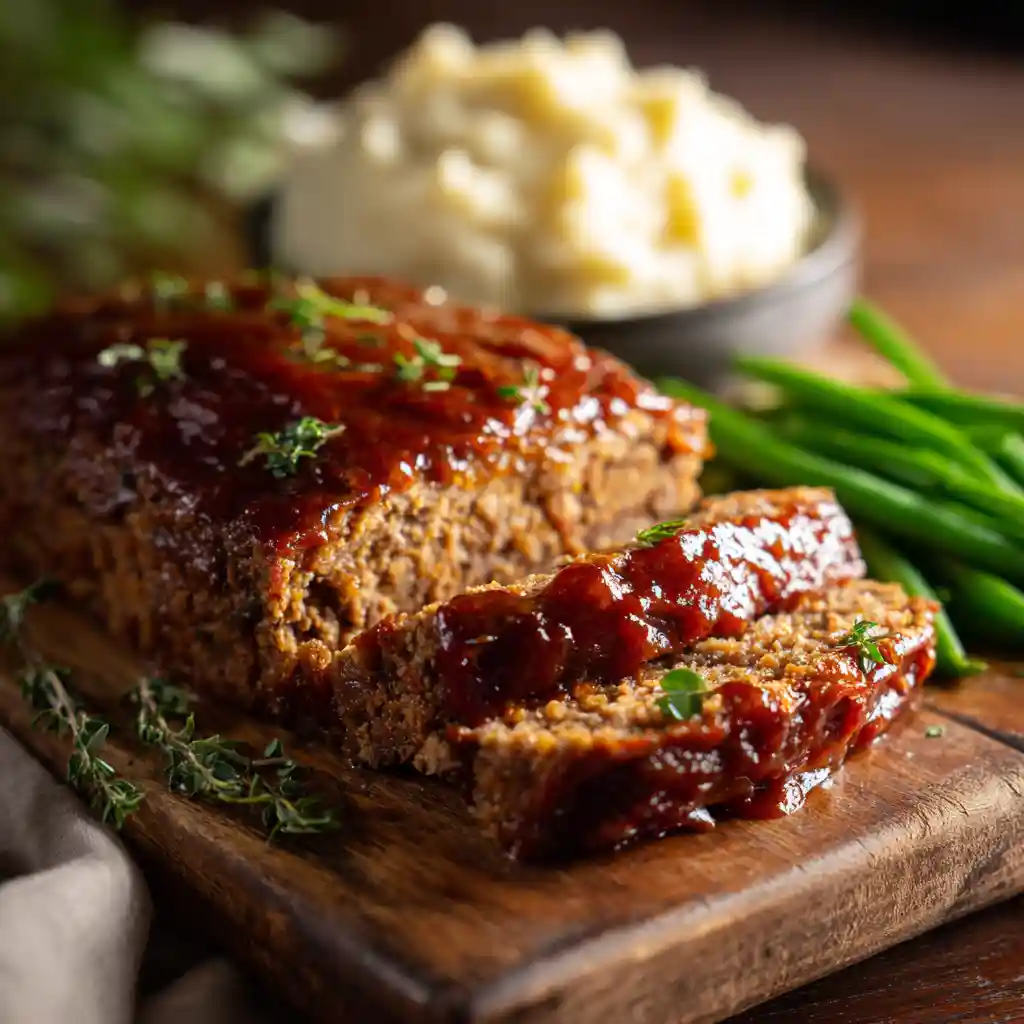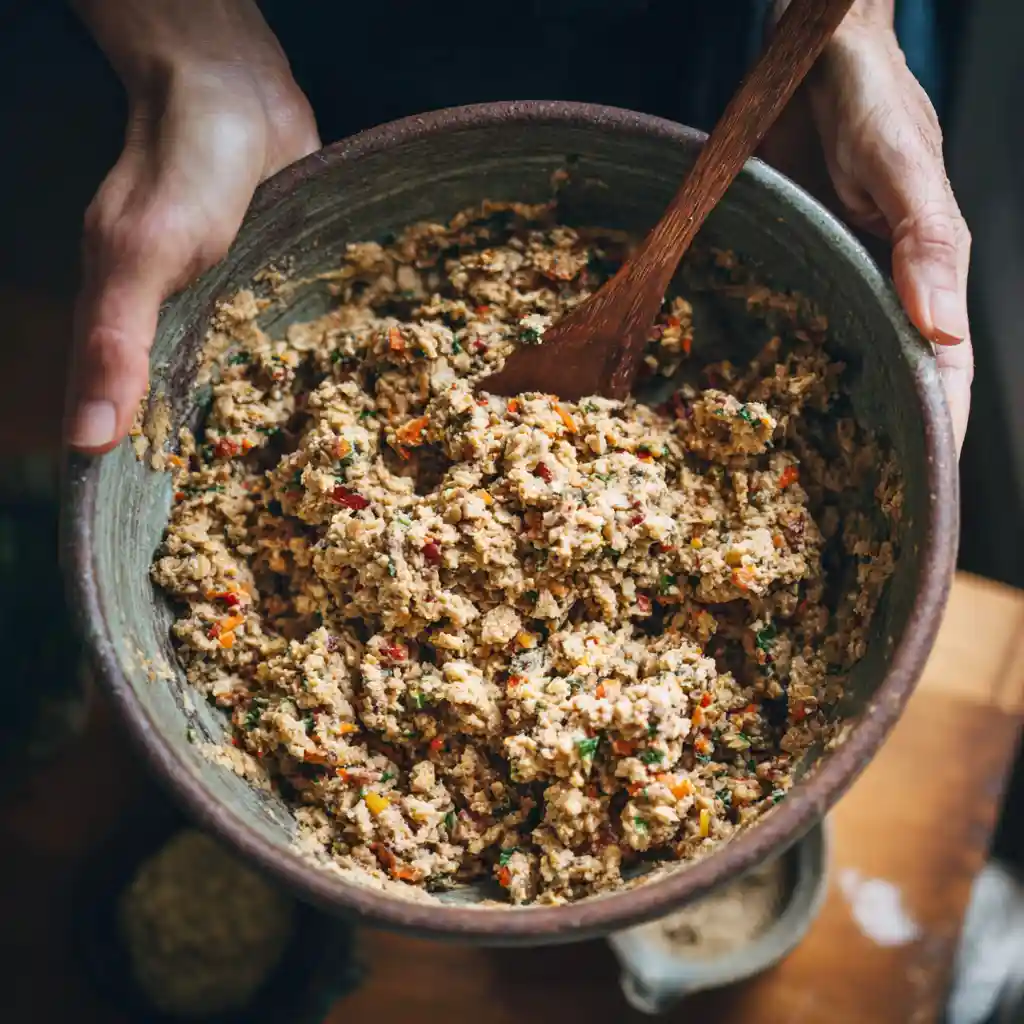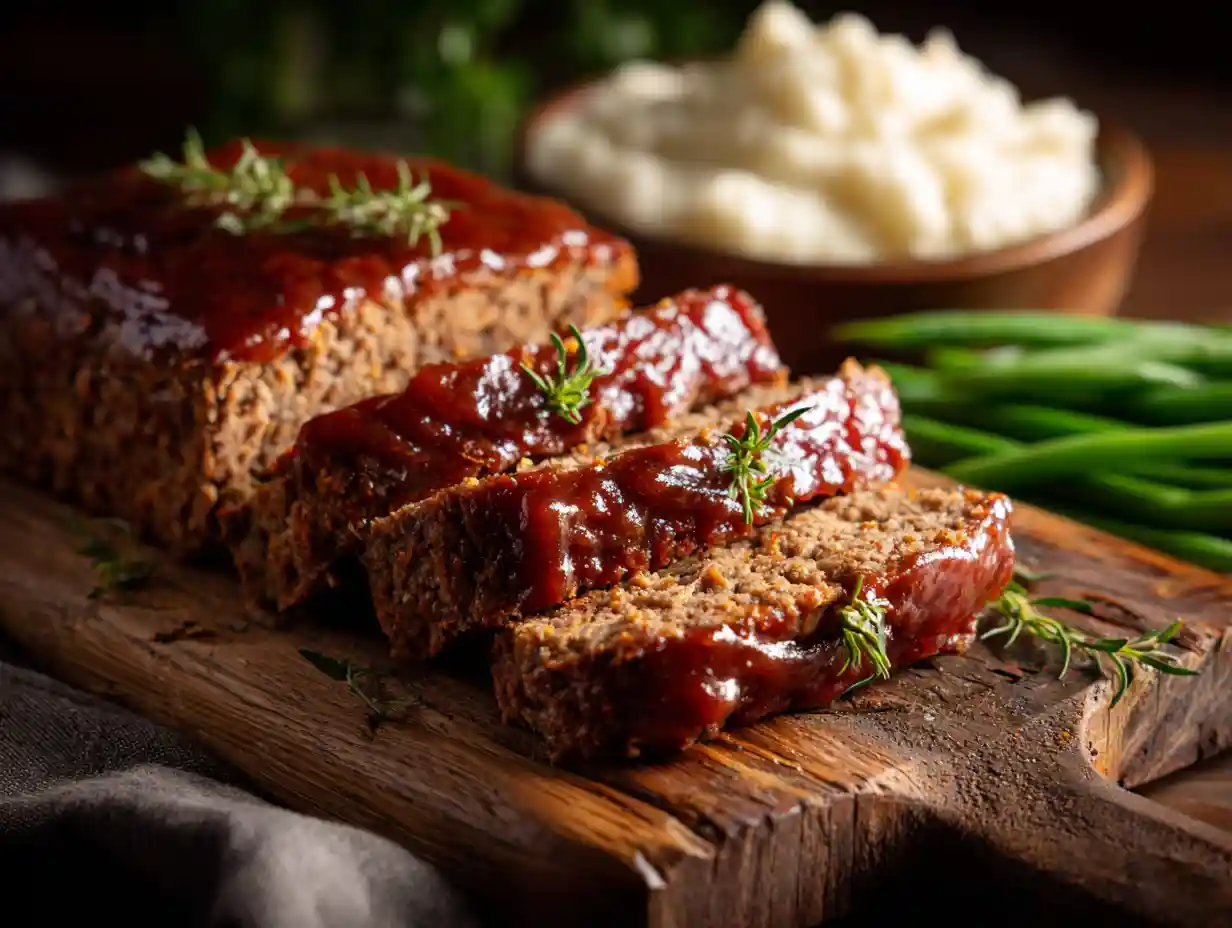Let’s be honest, vegan meatloaf has a reputation problem. If you’ve ever bitten into one hoping for cozy, Sunday-dinner nostalgia and got a mushy, flavorless block instead… yeah, you’re not alone. That’s exactly why this recipe exists.
This isn’t just a “meh, it’s healthy” type of loaf. It’s a hearty, savory, slice-it-and-sauce-it kind of situation that actually satisfies. Built from whole food ingredients (no processed stuff in sight), it brings that perfect fork-tender texture, a sticky-sweet glaze, and enough depth of flavor to convert even the meat-and-potatoes purists at your table.
Whether you’re cooking for a holiday spread, prepping weekday comfort food, or testing plant-based waters, this vegan meatloaf hits that sweet spot: satisfying, affordable, and surprisingly easy to make.

Stick around, I’ll walk you through the ingredients, pro-level tricks, and exactly how to avoid the usual vegan meatloaf fails. Let’s get this loaf right.
Want a quick, cheesy topping for your vegan meals? Check out our Tempeh Parmesan Cheese, nut-free, protein-packed, and ready in minutes.
Jump To
Ingredients for the Perfect Vegan Meatloaf
Here’s the thing, the best vegan meatloaf doesn’t rely on fake meats or mystery ingredients. It’s all about layering real, recognizable foods to build flavor, structure, and comfort-food satisfaction. Below is everything you’ll need (plus a few optional add-ins to make it your own).
Base Ingredients
- 1 tablespoon olive oil – for sautéing
- 1 medium onion, finely chopped
- 2 garlic cloves, minced
- 1 cup grated carrot
- 1 rib celery, finely chopped
- 1 ½ cups cooked lentils (brown or green; not mushy)
- 1 cup cooked brown rice or quinoa
- ¾ cup rolled oats or oat flour (acts as a binder)
- 2 tablespoons ground flaxseed + 5 tbsp water (flax “egg”)
- 3 tablespoons tomato paste
- 1 tablespoon soy sauce or tamari
- 1 teaspoon smoked paprika
- ½ teaspoon dried thyme
- Salt & pepper to taste
Optional Flavor Boosters
- 1 tablespoon miso paste – adds rich, salty umami
- ½ cup chopped walnuts or sunflower seeds – for crunch and richness
- 1 teaspoon balsamic vinegar – subtle tang that balances sweetness
- Pinch of cayenne or chili flakes – if you like a little heat
For the Glaze
- ¼ cup ketchup
- 1 tablespoon maple syrup
- 1 teaspoon mustard or balsamic vinegar
What if I’m missing an ingredient?
No stress. This recipe is flexible. You can swap rice with quinoa, skip the walnuts for a nut-free version, or use canned lentils to save time. I’ll cover all the best substitutions in a dedicated section below.
Craving bold flavor with a probiotic punch? Try our High-Protein Vegan Kimchi, it’s a spicy, gut-loving twist on a fermented classic.
How to Make Vegan Meatloaf (Step-by-Step Instructions)

No complicated techniques here, just a few simple steps that turn pantry staples into something you’ll actually crave. The key? Getting that perfect mix of moisture, texture, and seasoning.
Step-by-Step:
- Preheat the oven to 375°F (190°C) and lightly grease a loaf pan or line it with parchment paper. This helps with easy removal (and cleanup).
- Sauté the aromatics.
Heat the olive oil in a skillet over medium heat. Add the onion, garlic, carrot, and celery. Cook for 5–7 minutes until softened and fragrant. Let cool slightly. - Make your flax egg.
In a small bowl, mix the ground flaxseed with water. Set aside for 5 minutes until it gels, this binds everything together. - Mash and mix.
In a large bowl, combine the lentils, sautéed veggies, cooked rice/quinoa, oats, tomato paste, soy sauce, spices, and flax egg. Use a potato masher or fork to mash about half the mixture. You want some texture but enough mush for binding. - Taste before baking.
This is the moment. Taste your mix and adjust salt, pepper, or spice before it goes in the oven. Once it’s baked, no going back. - Shape and glaze.
Press the mixture firmly into the loaf pan. In a small bowl, mix ketchup, maple syrup, and mustard for the glaze. Spread evenly on top. - Bake.
Bake for 45–55 minutes, until the edges look firm and browned. Let it rest for at least 10 minutes before slicing, it firms up as it cools.
Can I make this without a loaf pan?
Absolutely. You can shape the loaf by hand on a parchment-lined baking shee, just make sure it’s compact. You can even use a muffin tin for individual portions (great for freezing or packed lunches).
Tips & Tricks for a Flavor-Packed Vegan Loaf
Let’s call it like it is, most disappointing vegan meatloaves fail in one of three areas: texture, seasoning, or structure. Here’s how to avoid every one of those pitfalls and make your loaf unforgettable (in a good way).
Amp up the umami
Umami is that deep, savory vibe we all love in traditional meatloaf. Luckily, there are plenty of vegan ways to get there:
- Add miso paste or a splash of tamari to the mix.
- A spoon of tomato paste (don’t skip it!) adds acidity and depth.
- Sautéed mushrooms or a dash of smoked paprika can trick your brain into tasting something “meaty.”
Structure matters more than you think
If you’ve ever made a loaf that crumbled on the plate or stayed mushy in the middle, you’re not alone. A few fixes:
- Let it cool before slicing. It firms up as it rests.
- Mash the mixture only partially to create stickiness without losing texture.
- Don’t overdo the moisture. If your lentils or veggies are extra wet, blot or drain them first.
Sneaky protein boosters
Want more plant power? Add:
- Chopped walnuts for protein and a meaty chew.
- Hemp seeds or sunflower seeds for texture.
- Nutritional yeast for a cheesy umami layer.
Freezer-friendly hacks
- Bake now, slice later: freeze individual slices with parchment in between.
- Or prep the unbaked loaf, freeze it raw (without glaze), and bake it fresh when needed, just add 10–15 minutes to the cook time.
Why does my vegan loaf taste bland?
It usually comes down to under-seasoning or skipping flavor bases like sautéed onions, tomato paste, or herbs. Always taste the mixture before baking, that’s your one chance to adjust it.
Substitutions & Variations
No two kitchens (or cravings) are the same. Whether you’re dealing with allergies, picky eaters, or just an empty pantry, this vegan meatloaf is wildly flexible. Here’s how to tweak it without losing flavor or structure.
Gluten-Free Version
- Swap soy sauce for tamari (it’s naturally gluten-free).
- Make sure your oats are certified GF, many aren’t by default.
- Avoid breadcrumbs (if using any) unless labeled gluten-free.
Nut-Free Option
- Skip the walnuts or sunflower seeds entirely, or replace them with toasted pumpkin seeds or a bit more oats.
- This swap works especially well for lunchbox-friendly loaves in allergy-aware households.
No Lentils? No Problem.
- Use cooked black beans or chickpeas. Mash them a bit more to get the same binding power.
- Even canned lentils will do in a pinch, just drain and rinse thoroughly.
Kid-Friendly Tweaks
- Go easy on the onions and spices.
- Shape the mixture into mini loaves or bake in muffin tins, faster, more fun to eat, and easier to portion.
Add-Ins to Keep It Interesting
- Mushrooms: finely chopped and sautéed, add meatiness.
- Sun-dried tomatoes: chopped for bursts of savory-sweet tang.
- Spinach or kale: sautéed and folded in for a green boost.
Can I turn this into burgers or meatballs?
Yes! Shape the mixture into patties or balls and bake or pan-fry. You’ll want to firm them up in the fridge for 20 minutes beforehand so they hold their shape. Great for batch prepping lunches.
Vegan Meatloaf FAQs
Can I freeze vegan meatloaf?
Yes, and it freezes beautifully. You can freeze the whole loaf after baking (just let it cool completely first) or slice it and wrap individual portions. For best results, reheat in the oven or air fryer to crisp the edges back up.
What’s the best binder for vegan meatloaf?
Flax eggs (ground flax + water) are the go-to. They help hold everything together without eggs. You can also use chia seeds, breadcrumbs, oat flour, or mashed beans, anything that thickens and holds shape when cooked.
How do I keep it from falling apart?
It’s a combo of the right texture and patience. Make sure you:
Don’t over-blend the mix (leave some chunks).
Let it cool before slicing, it firms as it sits.
Use a solid binder (like flax, oats, or tomato paste).
Can I prep this a day ahead?
Absolutely. It actually improves the next day. You can:
Mix and shape the loaf, then refrigerate overnight and bake fresh.
Or bake it fully, refrigerate, and reheat with the glaze just before serving.
Is this soy-free?
It can be! Swap soy sauce for coconut aminos or liquid aminos. All other ingredients are naturally soy-free, just double-check your miso or tomato paste if using store-bought.
Final Thoughts – Why This Vegan Meatloaf Works
If you’ve made it this far, you already know, this isn’t your average vegan meatloaf. It’s what happens when comfort food gets a plant-powered upgrade without sacrificing flavor, texture, or that nostalgic, dinner-table magic.
Whether you’re serving it for the holidays, meal prepping for the week, or just craving something grounding and hearty, this recipe gives you all the feel-good vibes without the heaviness.
Give it a try, make it your own, and don’t be surprised if someone asks, “Wait, this is vegan?” That’s your cue to smile.
Love cozy plant-based recipes like this? Follow us on Pinterest for more vegan comfort food ideas, weeknight dinners, and seasonal favorites!

Vegan Meatloaf Recipe
Ingredients
Equipment
Method
- Preheat the oven to 375°F (190°C). Lightly grease or line a loaf pan with parchment paper.
- Sauté the onion, garlic, carrot, and celery in olive oil over medium heat until softened (5–7 minutes). Let cool slightly.
- Make the flax egg by mixing ground flaxseed with water. Let it sit 5 minutes to gel.
- In a large bowl, combine lentils, sautéed veggies, rice, oats, tomato paste, soy sauce, spices, and flax egg. Mash about half the mixture to create binding while retaining some texture.
- Taste the mixture and adjust seasoning as needed.
- Press the mixture into the prepared loaf pan. Mix glaze ingredients in a small bowl and spread evenly over the top.
- Bake for 45–55 minutes, until firm on the edges. Let rest for at least 10 minutes before slicing.
Nutrition
Notes
Tried this recipe?
Let us know how it was!Printable Recipe Card
Want just the essential recipe details without scrolling through the article? Get our printable recipe card with just the ingredients and instructions.





1 thought on “The Best Vegan Meatloaf Recipe (That Even Meat Lovers Crave)”